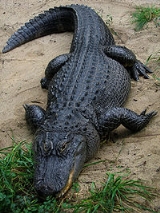
Crocodilia
Overview
Crocodilia is an order of large reptile
s that appeared about 84 million years ago in the late Cretaceous
Period (Campanian
stage). They are the closest living relatives of birds, as the two groups are the only known survivors of the Archosaur
ia. Members of the crocodilian total group
, the clade
Crurotarsi
, appeared about 220 million years ago in the Triassic
Period and exhibited a wide diversity of forms during the Mesozoic
Era.
Although the term 'crocodiles' is sometimes used to refer to alligators, caiman, and gharials
, or even to their distant prehistoric relatives the marine crocodiles
, a less ambiguous vernacular term for this group is 'crocodilians'.
The group is often spelled 'Crocodylia' for consistency with the genus Crocodylus
(Laurenti
, 1768).
Reptile
Reptiles are members of a class of air-breathing, ectothermic vertebrates which are characterized by laying shelled eggs , and having skin covered in scales and/or scutes. They are tetrapods, either having four limbs or being descended from four-limbed ancestors...
s that appeared about 84 million years ago in the late Cretaceous
Cretaceous
The Cretaceous , derived from the Latin "creta" , usually abbreviated K for its German translation Kreide , is a geologic period and system from circa to million years ago. In the geologic timescale, the Cretaceous follows the Jurassic period and is followed by the Paleogene period of the...
Period (Campanian
Campanian
The Campanian is, in the ICS' geologic timescale, the fifth of six ages of the Late Cretaceous epoch . The Campanian spans the time from 83.5 ± 0.7 Ma to 70.6 ± 0.6 Ma ...
stage). They are the closest living relatives of birds, as the two groups are the only known survivors of the Archosaur
Archosaur
Archosaurs are a group of diapsid amniotes whose living representatives consist of modern birds and crocodilians. This group also includes all extinct non-avian dinosaurs, many extinct crocodilian relatives, and pterosaurs. Archosauria, the archosaur clade, is a crown group that includes the most...
ia. Members of the crocodilian total group
Crown group
A crown group is a group consisting of living representatives, their ancestors back to the most recent common ancestor of that group, and all of that ancestor's descendants. The name was given by Willi Hennig, the formulator of phylogenetic systematics, as a way of classifying living organisms...
, the clade
Clade
A clade is a group consisting of a species and all its descendants. In the terms of biological systematics, a clade is a single "branch" on the "tree of life". The idea that such a "natural group" of organisms should be grouped together and given a taxonomic name is central to biological...
Crurotarsi
Crurotarsi
The Crurotarsi are a group of archosauriformes, represented today by the crocodiles,...
, appeared about 220 million years ago in the Triassic
Triassic
The Triassic is a geologic period and system that extends from about 250 to 200 Mya . As the first period of the Mesozoic Era, the Triassic follows the Permian and is followed by the Jurassic. Both the start and end of the Triassic are marked by major extinction events...
Period and exhibited a wide diversity of forms during the Mesozoic
Mesozoic
The Mesozoic era is an interval of geological time from about 250 million years ago to about 65 million years ago. It is often referred to as the age of reptiles because reptiles, namely dinosaurs, were the dominant terrestrial and marine vertebrates of the time...
Era.
Although the term 'crocodiles' is sometimes used to refer to alligators, caiman, and gharials
Gavialidae
Gavialidae is a family of reptiles within the order Crocodilia. Gavialidae consists of only one surviving species, the gharial , which is native to India. Many extinct species are also known...
, or even to their distant prehistoric relatives the marine crocodiles
Thalattosuchia
Thalattosuchia is the name given to a clade of marine crocodylomorphs from the Early Jurassic to the Early Cretaceous that had a cosmopolitan distribution. They are sometimes colloquially referred to as marine crocodiles or sea crocodiles, though they are not actually members of Crocodilia.The term...
, a less ambiguous vernacular term for this group is 'crocodilians'.
The group is often spelled 'Crocodylia' for consistency with the genus Crocodylus
Crocodylus
Crocodylus is one of three genera from the Crocodylinae subfamily extending from the Crocodylidae family.Established species include three extinct species:* † Crocodylus acer - probably represents a distinct genus....
(Laurenti
Josephus Nicolaus Laurenti
Josephus Nicolaus Laurenti was an Austrian naturalist of Italian origin.Laurenti is considered the auctor of the class Reptilia through his authorship of on the poisonous function of reptiles and amphibians...
, 1768).

